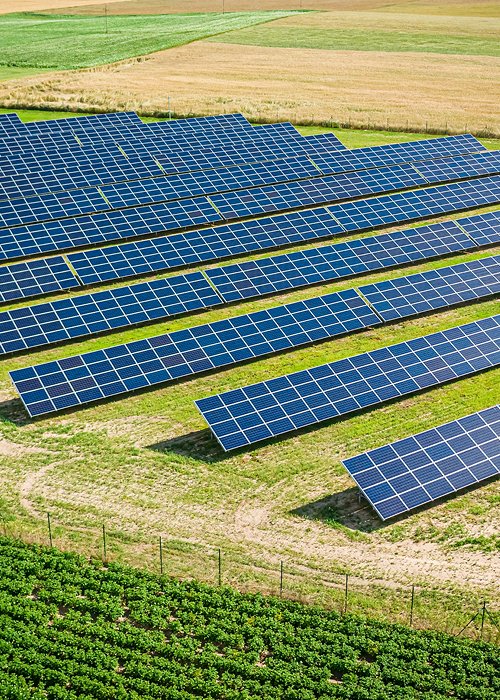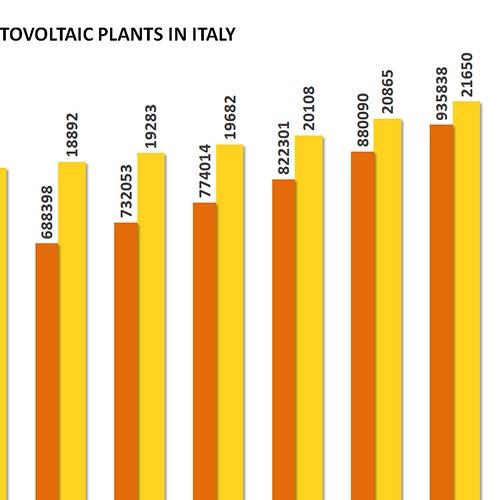The Sun is the main source of energy on our planet, from which we derive almost all the forms of energy we use on a daily basis, such as winds, fossil fuels and tides. Life on Earth depends on solar radiation: it is thanks to the sun’s rays that plants perform chlorophyll photosynthesis and trigger the perfect cycle that enables all organisms living on planet Earth to survive. Today, almost 150 years after the invention of the first photovoltaic cell, solar energy is the most promising renewable energy, one of the alternatives that will enable an energy transition to a more sustainable future. Let’s find out where Italy stands on development of this energy source and what the prospects are for the future.
Voice search

Solar energy in Italy: where do we stand?
A few facts about solar energy in Italy
Italy is one of the most virtuous countries in Europe and in the world for the production of renewable energy. According to data from Eni’s World Energy Review 2021, Italy was ranked sixth in the world for installed photovoltaic capacity in 2020 while, at a national level, solar energy is the most widely used renewable source after hydroelectricity. In 2020, energy from the sun covered 8.2% of electricity consumption in Italy (Source “Energy from renewable sources in Italy – Statistical Report 2020”, GSE). It should be noted here that solar energy in Italy basically means solar electricity, i.e. photovoltaics. The other major system, solar thermal, which uses the sun’s rays to directly heat fluids (often water), is indeed present but does not represent a significant share at present.
Where are the photovoltaic installations in Italy
The geographical distribution of Italian photovoltaic installations follows a distinctive pattern compared to other energy sources. The regional and provincial rankings change significantly depending on whether the number of installations or the installed capacity is assessed, since both the average size of the installations and the distribution of solar radiation across the country affect these statistics. Moreover, a lot changes according to whether you look at the overall figures or whether you look at the size of the region or province and population density.
The latest data provided by the Energy Services Operator (GSE), updated to 31 December 2020, were used to get an idea of the distribution of solar photovoltaics in Italy. Starting from the total number of installations and their installed capacity, 935,838 photovoltaic systems had been installed by the end of 2020, with a total capacity of 21,650 MW. During 2020, 55,550 photovoltaic systems were installed in Italy – the vast majority of which were smaller than 20 kW – with a total capacity of 749 MW.

In Italy, use of photovoltaics started in the 1970s: the first system was installed in 1979 at the Mandriola Pass. However, it was not until the 1990s that photovoltaics became more widely used, and this was further facilitated by the first government incentives, known as “Conto Energia”, in the 2000s. If we look at the graph on the increase in number and installed capacity of photovoltaic systems in Italy, it can be seen that photovoltaics in Italy started to accelerate at the beginning of this century. What can be observed is the fast initial growth, partly due to the Conto Energia incentives, followed by a consolidation phase starting in 2013, characterised by a more gradual development, due to termination of state subsidies. It should also be noted that the development of photovoltaics received a further boost in 2009, thanks to the European Directive that set the first targets in terms of production and consumption of energy from renewable sources (2009/28/EC).
The distribution of photovoltaic systems by number and installed capacity varies somewhat in Italian regions. At the end of 2020, only two regions accounted for 29.8% of the installations in Italy (Lombardy and Veneto, with 145,531 and 133,687 installations respectively). The national leader in terms of installed capacity is Puglia, with 2,900 MW (13.4% of the national total); this region also has the highest average plant size (53.4 kW). The regions with the lowest number of installations are Basilicata, Molise, Valle D’Aosta and the Autonomous Province of Bolzano.
The installations completed during 2020 did not cause significant changes in the regional distribution of plants. The installed power is concentrated mainly in the northern regions of the country (44.5%), followed by 37.4% in the south, and 18.2% in Central Italy. Puglia made the largest contribution to the national total (13.4%), followed by Lombardy (11.7%) and Emilia Romagna (10.0%). If we consider the number of plants, 55% are installed in the North, 17% in Central Italy and the remaining 28% in the South. The regions with the highest number of systems installed are Lombardy, Veneto, Emilia Romagna and Lazio.
Interestingly, there is no uniformity within individual regions. Indeed, looking at individual provinces, some are particularly unsatisfactory, because installations there account for only 0,1% of the national total, but there are also others whose results are truly excellent, such as Lecce, which alone covers 3.3% of installed photovoltaic power, followed by Cuneo, with 2.7%, and Viterbo and Rome with 2.2% each. Conversely, looking at the provincial map of the number of systems installed, the province of Rome is in the lead with 4.0% of the national total, followed by the provinces of Treviso and Brescia with 3.2%. Of the southern provinces, however, the one with the highest number of plants at the end of 2020 is Lecce (1.8%).
Finally, a few surprises emerge when assessing the installed energy density, i.e. power per square kilometre. For example, Marche, which is rather low in the other rankings, is actually the second region in Italy, with 119 kWh installed per square kilometre, preceded by Puglia at 148. The Marche region even takes first place when calculating per capita capacity (watts per inhabitant), with 744 W per capita, followed by other central and southern regions such as Puglia (738 W per capita), Basilicata (691), Sardinia (609), Molise (601), Abruzzo (587 ) and Umbria (577). Local areas are contributing positively to the energy transition, each according to their own excellences and peculiarities.
How much photovoltaic energy is produced in Italy
In 2020, the more than 935,000 photovoltaic systems operating in Italy produced a total of 24,942 GWh of electricity. Compared to the previous year, there was a +5.3% increase in production, mainly due to higher solar radiation. An analysis of the monthly trend in 2020 production shows that the highest production occurred in the summer months; July, in particular, was the month with the highest production (just over 3.1 TWh).

Obviously, production is concentrated in the summer months; July, in particular, is the month with the highest production (just over 3.1 TWh). In line with previous years, in 2020 the region with the highest photovoltaic production was Puglia with 3,839 GWh (15.4% of the total 24,942 GWh produced nationwide). Puglia was followed by Lombardy with 2,441 GWh and Emilia Romagna with 2,402 GWh, contributing, respectively, 9.8% and 9.6% of the country’s total production. For all Italian regions, positive changes in production were observed in 2020 compared to the previous year; the region with the most significant increase was Sardinia (+16.3% compared to 2019), followed by Veneto (+9.0%) and the Autonomous Provinces of Bolzano and Trento (+8.7% and +8.5%, respectively).
Considering the sectors in which solar energy is used, at the end of 2020 about 81% of installations in operation in Italy were concentrated in the domestic sector; the largest share (51%) of the total installed capacity was in the industrial sector. Looking at 2020 alone, 86% of the systems installed during the year were in the domestic sector; in terms of power, 45% were in the industrial sector.
What kind of photovoltaics?
Photovoltaics is a sector where there is no shortage of growth and technological innovation. Various technologies and materials are entering the market, demonstrating high efficiency and allowing an increase in energy production by using surfaces not directly exposed to direct solar radiation. However, Italian photovoltaics are still almost entirely based on silicon: polycrystalline silicon is used prevalent in all regions, followed by monocrystalline silicon. Thin-film panels or panels made of other alternative, higher-performance materials are not widely used.
The comparison between panels installed on the ground, i.e. with fixed support structures or solar trackers, standing directly on the ground, and those installed on the roofs of houses, sheds, canopies, etc. is also significant. To date, there is a slight prevalence of “rooftop” panels – 58% versus 42% – but with very marked differences at local level. For example, in Liguria, Valle d’Aosta and the provinces of Trento and Bolzano more than 90% of installations are not on the ground, while in Puglia and Basilicata there are less than 30% on roofs, and all the rest are directly on the ground. In general, there is a marked difference according to latitude, with rooftop installations tending to decrease in percentage when moving from north to south.
One of the most important innovations appearing on the Italian scene regards storage systems, which collect photovoltaic energy produced but not immediately consumed. And while there is certainly a trend towards installing panels on everyday objects and devices – from vehicles to smartphone accessories – thermodynamic solar panels are also emerging. Thanks to special mirrors that concentrate the energy arriving from the sun in a single point, it is possible to heat the receiver (a tube called a solar collector in which a mixture of molten salts flows) up to temperatures of 400-600°C, achieving even greater efficiency than traditional panels. The leading region in Italy, at least in the start-up phase, is Sicily, but in general, projects and experiments are being launched for the entire southern part of the country, both for domestic and industrial energy use.
By Benedetta Palazzo




